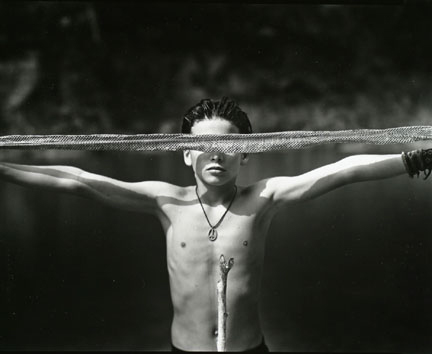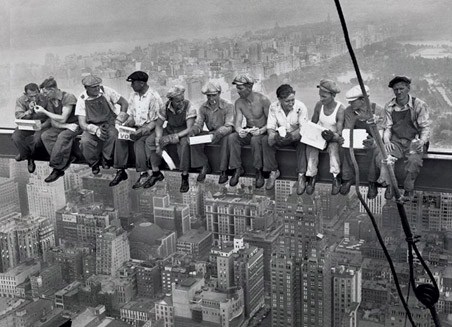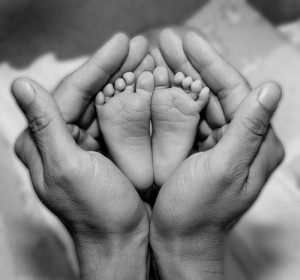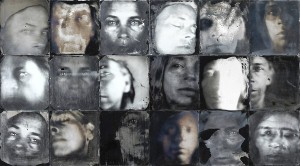Life is but a dream
Notes on a talk by Simone Moir at Centre of Gravity, October 9, 2012
I’m a Gestalt psychotherapist, Yoga practitioner and teacher, a meditator, and I run a space called the Parkdale Prana Room (a bodymind therapy and practice space.) I studied in the Tibetan Shambhala tradition and this influence will likely show up in my talk tonight. I’m also responding to the talks Michael (Stone)’s been giving the last five weeks on Carl Jung, looking at one piece – the dream – and Jung’s fascination with them. He took them so seriously. Dreams seem to prove we exist. The shadow confirms its object. The dream confirms: I am a dreamer.
Cocoon
I dreamt last night that I was in a room just like this one, standing by the windows. Oh, the windows, let me tell you about them for the rest of my life… We can get engrossed in details, in the fascinated minutae of our dream worlds. We are thrilled by the otherness of our dreams as if we weren’t aware that we are busy creating dreams all the time. We’re in the process of projection all the time. Our dreams and fantasies point to a larger life we could experience, that bring us closer to a greater sense of ourselves. Mostly we live in a small version of ourselves. In the Shambhala tradition this small self is called a cocoon. It is a predictable, comfortable, familiar way of being that is also kind of stale. It’s like the smell of your armpit: it’s comforting and close. There’s something about a cocoon that’s boring. This version of ourselves needs so much entertainment. So much tending to. No sooner has it eaten than it needs more tastes. We need new excitements, new distractions. There is a constant thirst for excitement and hunger for new experiences. We aren’t content with our life the way it is.
From William Gordon’s Path of the Warrior (http://www.quietspaces.com/Shambhala/shambhala.html):
“By not projecting emotions, we can see how they originate, what nourishes them, how to go beyond them. So, as I say, emotions are energy, and there is nothing wrong with them. However, they are often connected to old systems, so that their main engine is fear. By going within our frozen attitudes, by melting them in our meditation practice, we find unlimited goodness within the energy of joy or anger, passion or fear, peace or anxiety. These frozen attitudes have a name in Shambhala. We call them ‘cocoon.’
Cocoon is the protection we have built for ourselves of our view of self and of the world. Many aspects of cocoon begin when we are very young, so the roots of our different protective strategies are not immediately visible to inspection. We want the world to exist in ways that confirm our preconceptions. It was said by one psychologist that we continue to look constantly for information that ‘matches our perceptions.’ Each of us, thus, sees a different world. That world exists in our minds as various systems of belief. The way to cut through cocoon is to use the tools of meditation to first quiet the mind and secondly, to see into the patterns of cocoon.”
Enough
Literature is proof that life is not enough – Fernando Pessoa, Portuguese poet translation from Italian by my friend
Is the dream proof that waking life is not enough? In Michael’s talks on Jung, we began to explore how the unconscious accesses our conscious lives through dreams and fantasies and images. We heard about Jung’s idea that the unconscious was compensatory, when the ego shrank the world too much, the unconscious would show up and connect it with something bigger again. The idea of ‘accepting what comes up’ and ‘dropping into an image’ was mentioned. One of the ways we do that is via meditation. But where do we go from there, how can we drop in a more extended way?
In this talk I will present means for working with images, fantasies and dreams through an understanding of the process of projection as it is defined by Buddhism. We will look at how the buddhadharma uses the dream as an image for how we can break down the mind’s projections. We will also try some experiments to inquire into the nature of our projections as they are happening in the here and now.
Vow
First let’s look closely at the process of projection. To understand the process of projection is to understand the functioning of the mind
The Sadhana of Mahamudra – a bodhisattva vow
In the spontaneous wisdom of the trikaya,
I take refuge with body, speech and mind.
In order to free those who suffer at the hands of the three lords of materialism.
And are afraid of external phenomena, that are their own projections,
I take this vow in meditation.
Trikaya deserves a talk all its own, but for now we might say it is about awakening. The refuge that is being taken, is taken in body, speech and mind – not in a deity. The three lords of materialism are samsara. But tell me: why are we afraid of external phenomena?
Two
Projection is a form of splitting. When we project we create duality. Duality is a process of erecting a boundary between I and Not I – which is how we create an ego. The ego verifies that the self is real. We create a reference point, an ‘I,’ in relation to an other/object. And this fixes or verifies the self as real. ‘Realness’ is based on duality. I am not that, I am this.
How can we have such amnesia of this process? How can we forget what we have projected? This is the ignorance named “wrong view” by the Buddhists, “avidya” by the Yogis. As the feeling of interdependence arrives (Tam Tat Asi “I am that”) it begins to cut through the process of projection and splitting. The mind is that which projects.
“In Buddhism, mind is what distinguishes sentient beings from rocks or trees or bodies of water. That which possesses discriminating awareness, that which possesses a sense of duality – which grasps or rejects something external – that is mind. Fundamentally, it is that which can associate with an “other” – with any ‘something” that is perceived as different from the perceiver. That is the definition of mind. The traditional Tibetan phrase defining mind means precisely that: ‘That which can think of the other, the projection, is mind.’
Mind develops its particular nature as that perception begins to linger on something other than oneself. Mind makes the fact of perceiving something else stand for the existence of oneself. That is the mental trick that constitutes mind.” Chogyam Trungpa, Heart of the Buddha (4 Foundations of Mindfulness)
Cushion
This Buddhist inquiry goes to the heart of psychological functioning and looks closely at the ongoing creative process of consciousness and ego formation in a way that Western psychology has only become interested in recently. Let’s take an example of projection. This cushion for instance. It’s “soft”, the form is contained, it’s a supportive structure for my meditation practice. It’s “my” cushion. Who am I in relation to this cushion? What qualities do I possess in relation to this cushion? As I feel my cushion, I notice my firmness. I can feel how it is fixed, while I am relatively free to move around. In other words: when I am with my cushion, I show up in a certain way. If we examine a different set of projections, for instance around an object like a table, then there is a different self produced. Who am I, who do I become, who I show up as in relation to the hardness of this table? We can only know ourselves relationally.
MindBody
Let’s look at a projection that is very close to home for all of us. The projection of the body. Or what is typically referred to as the mind-body split.
“I am my head, but I own my body. The body is an object, a projection.” Ken Wilbur, No Boundary
Listening to our speech about our bodies can give us an indication of how we create and maintain a split between mind and body. One of the ways we can discern our projections is through language, the way we talk about our experience. How do we speak about our body?
- Will say I move my arm; won’t say I beat my heart
- Will say I close my eyes; won’t say I grow my hair
- Will say I wiggle my toes; won’t say I circulate my blood
All those actions that are voluntary and controllable the ego will identify with. Actions that are spontaneous and involuntary are untrusted, not-self or objectified. If I can’t control it, it’s not me. If the actions are spontaneous, it’s not me. Then who is it? Who is this body? Or is it all just stuff? What do you imagine is the impact of throwing away all this projected content of the body? Disavowing everything that is spontaneous and involuntary. Do we care? In many ways, this is a relationship that works, it’s functional. And then sometimes I wonder: what would it like if your leg could control your day?
Disown
Isn’t it strange to call only one half of yourself you? Who is the other half? We often associate growing up and adulthood with volition. Taking charge. Being in control of one’s life. We know we like, we embrace, the controllable part of our life. This is what I’ve decided to do with my day. Not what my bowels have decided to do with my day. When my bowels decide, then I’m unhappy.
“…Like all projections this alienation of the body only results in the projected body returning to haunt the individual, clobbering her in the most agonizing of ways and worse yet with her own energy.” Ken Wilbur, No Boundary
Why do we disown our bodies?
“There are all sorts of reasons why we abandon our bodies and why we fear to reclaim them. We fear to reclaim our bodies because it houses in a particularly vivid and living form, strong emotions and feelings which are socially taboo. And ultimately it is the abode of death.” Ken Wilbur, No Boundary
All psychosomatic projections come back to haunt us. For example, anxious persons project their anger onto the environment, and then it presses back into them. Depressed persons project anger onto the flesh. The body contains emotions that are socially unacceptable. The body is the house of death.
It’s difficult to see our own projections, until they don’t match up; either they feel true or they feel off. How can you tell? Because you’re in relationship with someone, and they let you know.
Floor
Contacting the back body and yielding to the ground. Lie down on your back if possible with arms overhead gently by your sides. Pay attention to the places where you body makes contact with the floor. Scan your back body to notice the differing sensations of contact with the floor. Are there places where the contact feels complete? Or lacking? Notice what happens when you consider that the floor is coming to meet your body?
As you experience the floor right now, consider… what is the quality of the floor that comes to meet you? How would you describe how the floor shows up for you in this moment? How would you describe your experience of how the floor meets you in words?
Find a partner. Share with your partner a statement about how the floor met you. (one sentence) Now try saying the sentence to your partner exchanging “the floor” with “you.” (eg. The floor is steady and reliable. You are steady and reliable.) What did you notice when you said this to your partner?
We explored our projections on to the floor. Have you experienced a relationship with those qualities before? Who did you meet in the floor? (It can be awkward to be presented with the unwanted gift of your projection.)
Splits
“This (mind-body) split cannot be overcome by knowledge. Knowledge is a surface phenomenon – and belongs to the realm of the ego. One has to feel the flow of and sense the course of the excitation in the body. To do this however, one must give up the rigidity of one’s ego controls so that the deep body sensations can reach the surface.” Alexander Lowen, of Bioenergetics.
Contrast this view with The Four Foundations of Mindfulness. In The Four Foundations of Mindfulness a powerful tool for working with projections is presented. Mindfulness of the body speaks directly to the split between mind and body. As we experience the sensation of our breath, instead of the idea of our breath, we enter the body of our processes – both voluntary and involuntary. In this way we work on reclaiming our projections as we practice. As projections arise, we experience them, and then let them go.
The psychosomatic body. To begin with, there is some problem about what we understand by the body. We sit on chairs or on the ground; we eat; we sleep; we wear clothes. But the body we relate with in going through these activities is questionable. According to the tradition, the body we think we have is what is known as a psychosomatic body. It is largely based on projections and concepts of body. This psychosomatic body contrasts with the enlightened person’s sense of body, which might be called body-body. This sense of body is free from conceptualizations. It is just simple and straightforward. There is a direct relationship with the earth.
Chogyam Trungpa: “As for us, we do not actually have a relationship with the earth. We have some relationship with body, but it is very uncertain and erratic. We flicker back and forth between body and something else – fantasies, ideas. That seems to be our basic situation. Even though the psychosomatic body is constituted by projections of body, it can be quite solid in terms of those projections. We have expectations concerning the existence of this body, therefore we have to refuel it, entertain it, wash it. Through this psychosomatic body we are able to experience a sense of being.
Mindfulness of body brings this all-pervasive mind-imitating-body activity into the practice of meditation. The practice of meditation has to take into account that mind continually shapes itself into body-like attitudes. Consequently, since the time of Buddha, sitting meditation has been recommended and practiced, and it has proved to be the best way of dealing with this situation.” Chogyam Trungpa, Heart of the Buddha
Buddhist practices examine every particle of consciousness. If we could go back to the very beginning in the process of ego creation, as far back as possible in the process of consciousness to see whether there is in fact a beginning state, a platform, a solid untainted self, or however you want to call it. Can we find an original entity of self before the projecting began?
Self
In meditation what we find is that there is no original entity, no self. Instead, we are continuously in a process of projecting our world and living in its shadow.
What we cast outside the boundary of self has tremendous richness and power. Working with projections as we do in meditation is to reclaim what we threw away. What do we do with what we have reclaimed? Do we hold onto the rich new bits that we encounter in our recovery? Do we just become a bigger richer ego?
The Buddhadharma pulls the rug out from any project to reclaim or fortify a self. As we can see in the practice of sitting meditation and mindfulness of body the Buddhadharma does present reclaiming our projections as a way of working with them. When we hear the instruction to just accept whatever arises, this is what is meant. But we don’t reclaim them just so that we can attach them to a previously existing solid entity.
If I am a solid entity of ‘Simone-ness’ and I reclaim a disowned quality of bossiness, I am still stuck in a delusion. From a Buddhist perspective, this larger notion of self (my bossiness + my other qualities such as attentiveness) is too rigid, and it isn’t even true. I am holding on to a past fleeting moment. I now have a dream about my bossiness that I am holding onto. We can only reclaim in a fleeting moment-by-moment way.
Read
“Trying to find the moment when one thought becomes the other is like trying to find the moment when boiling water turns to steam. Yet we habitually string our thoughts together into a story that tricks us into believing that our identity, our happiness, our pain, and our problems are all solid and separate entities. In fact, like thoughts, all these passing constructs are constantly changing. Each situation, each thought, each word, each feeling, is just a passing memory.
Wisdom is a fluid process, not something concrete that can be added or measured. The warrior-bodhisattva trains with the attitude that everything is a dream. Life is a dream, death is a dream, waking is a dream, sleeping is a dream. The dream is the direct immediacy of our experience. Trying to hold onto any of it by buying our story line only blocks the wisdom.” Pema Chodrön, Comfortable With Uncertainty
Now we can come back to the significance of the dream as an image in the Buddhadharma. It is an image or a metaphor, but also a vivid experience. We know what it is like to have a dream and to remember our dreams.
Dharma Dreams
In Tibetan Buddhism we study what are called Lojong or slogan practice. It is a contemplation practice: Regard All Dharmas As Dreams. Dharmas are particles of reality, truth. Sensory bits of information, moments.
It points to the fact that things are not as solid or as reliable as they seem. Every situation is a passing memory. Dreams are just as convincing as waking reality.
What does regarding all dharmas as dreams mean for you in your life? What do you notice when you contemplate this way? What happens in your body?
The past has a dream-like quality, I feel all the hooks to things in my life, the hurts, the crutches, the desires. Aparigraha.
To connect with the open, spacious quality of your mind, so that you can see that there’s no need to shut down and make such a big deal about everything.” Pema Chodron, Start Where You Are A Guide to Compassionate Living
Euro Disney
Khenpo Tsultrim Gyamtso Rinpoche is a Tibetan Buddhist scholar yogi in the Kagyu lineage. He is famous for his flamboyant approach to teaching the densest of Tibetan Buddhist philosophical texts. He often teaches through songs of realization. From his mouth flow the songs of Milarepa (Tibet’s most famous yogi poet) and his own. On many occasions these songs are sung with spontaneous melodies. What is a yogi? A yogi is “an individual who has spent years in isolated retreats practicing secret self-transforming physical and mental exercises, extraordinary bodymind wisdom.”
Someone asked the Khenpo when he visited Toronto about five years ago how they could really experience the luminous emptiness of all phenomena and of the mind. He answered, “Go to scary movies, amusement park rides. And when you’re frightened, meditate by saying “This is a dream” or “I died and this is a bardo.” Go to Euro Disney, Space Station 2 and you’ll be thrown into nonconceptual states!”
Rinpoche continued: “This is a great way to practice Mahamudra – which is meditation on fear of whatever’s happening in our mind. Mahamudra is a very vivid meditation because you look directly at your own mind and relax – that’s the supreme meditation. If you meditate in this way, suffering won’t be unbearable. When you’re up in the dark, flipping around, you don’t have much time to think of anything. If you practice like this, you’ll be able to do it in a moment of great fear. In the modern world it is impossible to avoid dangerous, frightening activity, but if we embrace fear and difficulty and cultivate the meditation of looking directly into its essence, and relax into it, then it’s not difficult. And if you train now, when you face difficulty, such as death, you’ll be able to meditate.”- Felix King in Ascent Magazine, 2007
My understanding of the view on this practice:
- know that these people are acting/that the ride is built and tested to be safe
- Recognize that you are watching a movie this is not actually happening or the ride is built to specifically to scare you
- You feel like I’m going to die but it is all made up.
- Look at how much you are willing to believe your thoughts so much so that your bodies responses begin to confirm how you are perceiving things
- We put ourselves through these things we project onto the characters in the movie, we project on to the ride
- We can experience the duality of our heightened emotions and the recognition that this is just a projection.
- We can flicker back and forth in awareness
- An unstable unfixed state dislodges the solidity of existence we believe in
- We can experience the transparency of our terror and see right through it.
Summary
We believe our projections just like we believe our thoughts or emotions. We take ourselves our thoughts and emotions to be solid real permanent. Regarding life is but a dream opens us to the illusory nature of our stories of self. Working with projections is a process of becoming less rigid. We regard ourselves, and our stories, with softer edges. Claiming disowned aspects of self heals us, allowing us to become more whole. Being more whole we can be present to whatever arises with gentleness, flexibility and compassion. You practice where you’re hooked.




